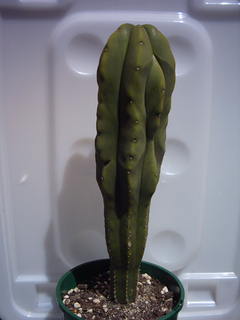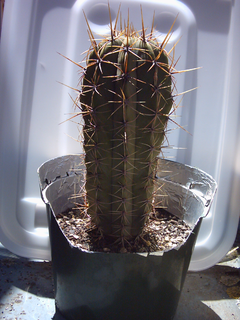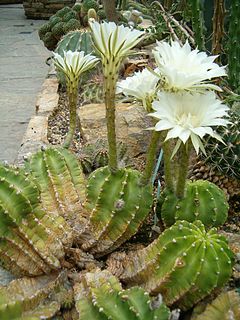
A cactus is a member of the plant family Cactaceae, a family comprising about 127 genera with some 1750 known species of the order Caryophyllales. The word "cactus" derives, through Latin, from the Ancient Greek κάκτος, kaktos, a name originally used by Theophrastus for a spiny plant whose identity is now not certain. Cacti occur in a wide range of shapes and sizes. Most cacti live in habitats subject to at least some drought. Many live in extremely dry environments, even being found in the Atacama Desert, one of the driest places on earth. Cacti show many adaptations to conserve water. Almost all cacti are succulents, meaning they have thickened, fleshy parts adapted to store water. Unlike many other succulents, the stem is the only part of most cacti where this vital process takes place. Most species of cacti have lost true leaves, retaining only spines, which are highly modified leaves. As well as defending against herbivores, spines help prevent water loss by reducing air flow close to the cactus and providing some shade. In the absence of leaves, enlarged stems carry out photosynthesis. Cacti are native to the Americas, ranging from Patagonia in the south to parts of western Canada in the north—except for Rhipsalis baccifera, which also grows in Africa and Sri Lanka.

Acanthocalycium is a genus of cactus consisting of several species from Argentina. The taxon name comes from Greek akantha and kalyx, which refers to the spines on the floral tubes.

Echinopsis is a large genus of cacti native to South America, sometimes known as hedgehog cactus, sea-urchin cactus or Easter lily cactus. One small species, E. chamaecereus, is known as the peanut cactus. The 128 species range from large and treelike types to small globose cacti. The name derives from echinos hedgehog or sea urchin, and opsis appearance, a reference to these plants' dense coverings of spines.

Echinocereus is a genus of ribbed, usually small to medium-sized, cylindrical cacti, comprising about 70 species native to the southern United States and Mexico in very sunny, rocky places. Usually the flowers are large and the fruit edible.

Echinopsis peruviana, the Peruvian torch cactus, is a fast-growing columnar cactus native to the western slope of the Andes in Peru, between about 2,000–3,000 m (6,600–9,800 ft) above sea level.

The term ceroid cactus is used to describe any of the species of cacti with very elongated bodies, including columnar growth cacti and epiphytic cacti. The name is from the Latin cēreus, wax taper, referring to the stiff, upright form of the columnar species. Some species of ceroid cacti were known as torch cactus or torch-thistle, supposedly due to their use as torches by Native Americans in the past.

Echinopsis lageniformis, the Bolivian torch cactus, is a fast-growing columnar cactus from the high deserts of Bolivia. Among the indigenous populations of Bolivia, it is sometimes called achuma or wachuma, although these names are also applied to related species such as Echinopsis pachanoi which are also used for their psychedelic effects.

Echinopsis scopulicola is a type of cactus native to Bolivia, which contains psychedelic compounds. Many claim this species contains mescaline, which was until recently unconfirmed due to the lack of official research, but a study published in September 2010 by the International Society for Ethnopharmacology placed it in the top third of the results for their samples. This included 14 taxa/cultivars of the subgenus Trichocereus of the genus Echinopsis, with Scopulicola noted to contain 0.82% mescaline/dry weight in the outer green layer.

Echinopsis spachiana, commonly known as the golden torch, (white) torch cactus or golden column, is a species of cactus native to South America. Previously known as Trichocereus spachianus for many years, it is commonly cultivated as a pot or rockery plant worldwide. It has a columnar habit, with a lime-green cylindrical body with 1–2 cm long golden spines.

Echinopsis macrogona, syn. Trichocereus macrogonus, is a species of cactus found in Bolivia.

Echinopsis pachanoi — known as San Pedro cactus — is a fast-growing columnar cactus native to the Andes Mountains at 2,000–3,000 m (6,600–9,800 ft) in altitude. It is found in Argentina, Bolivia, Chile, Ecuador and Peru, and it is cultivated in other parts of the world. Uses for it include traditional medicine and traditional veterinary medicine, and it is widely grown as an ornamental cactus. It has been used for healing and religious divination in the Andes Mountains region for over 3,000 years. It is sometimes confused with its close relative Echinopsis peruviana.

Echinopsis schickendantzii is a cactus found in Northwestern Argentina in provinces of Salta and Tucumán at elevations of 1600 to 3200 meters.

Echinopsis chiloensis is a species of cactus native to South America; genus members are known as hedgehog cacti, sea-urchin cactus or Easter lily cactus.
Many cacti are known to be psychoactive, containing phenethylamine alkaloids such as mescaline. However, the two main ritualistic (folkloric) genera are Echinopsis, of which the most psychoactive species is the San Pedro cactus, and Lophophora, with peyote being the most psychoactive species. Several other species pertaining to other genera are also psychoactive, though not always used with a ritualistic intent.

Echinopsis chamaecereus is a species of cactus from Argentina. Synonyms include Chamaecereus silvestrii and Lobivia silvestrii. It has been called the "peanut cactus", This plant should not be confused with Echinopsis silvestrii, another species with a very different appearance.

Echinopsis mamillosa is a species of cactus from Bolivia.

Echinopsis candicans is a species of cactus from northern and western Argentina. It has large fragrant white flowers that open at night.

Rebutia minuscula is a species of cactus from northern Argentina. It is the type species of the genus Rebutia.

Echinopsis atacamensis (cardón) is a species of cactus from Chile, Argentina and Bolivia. The wood of this species can be used in building and in making furniture.

Echinopsis eyriesii is a species of cacti of the genus Echinopsis.


















